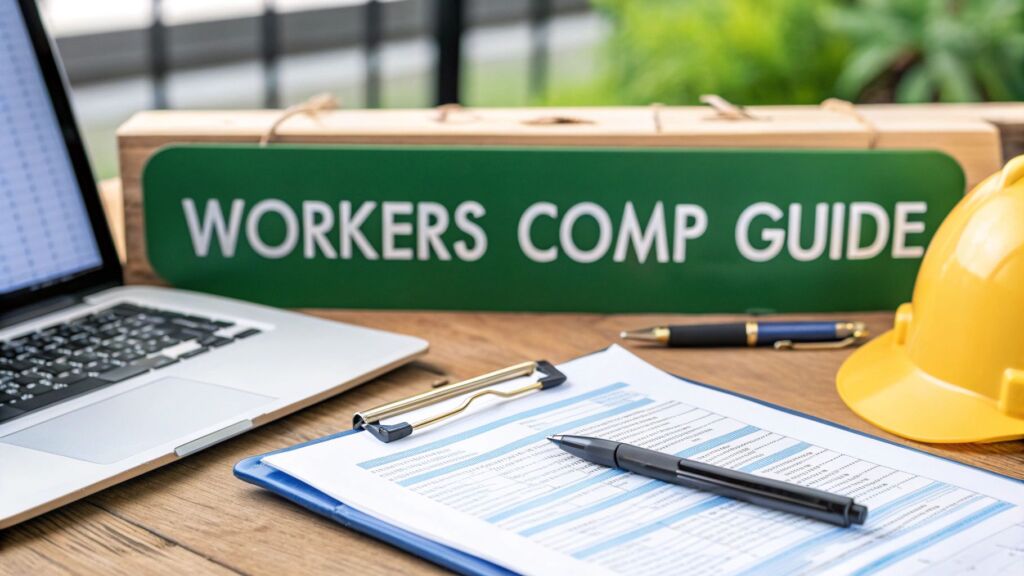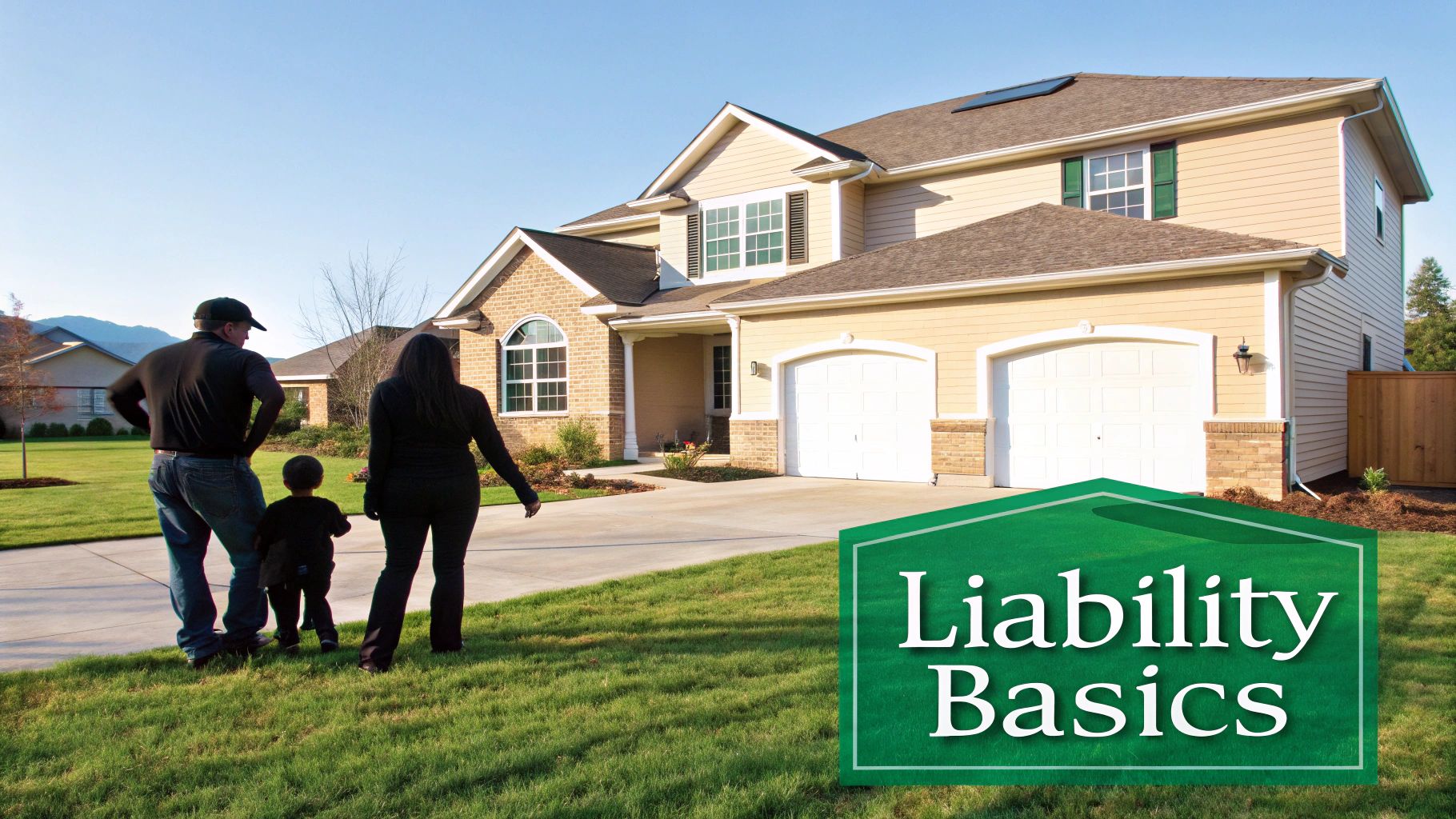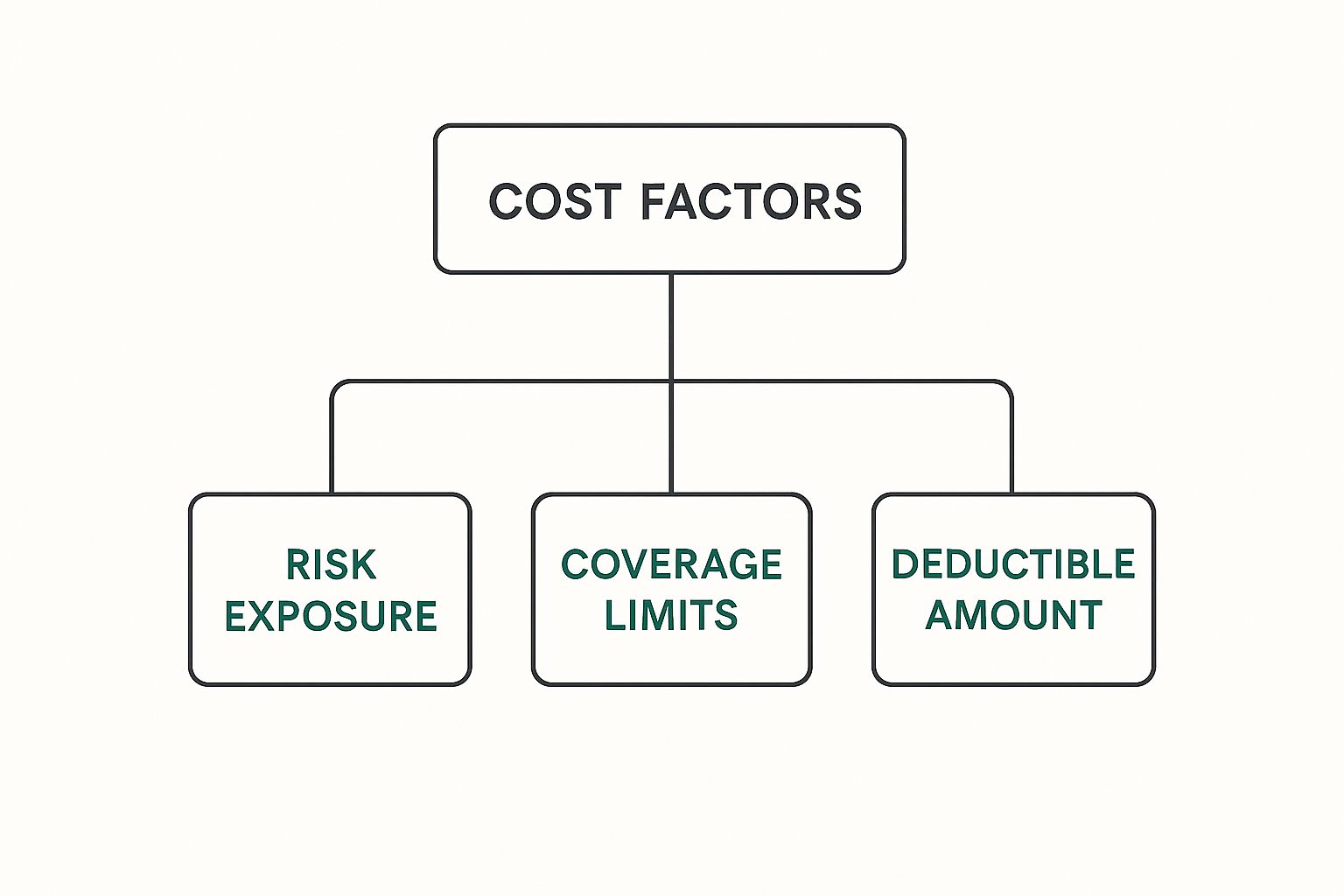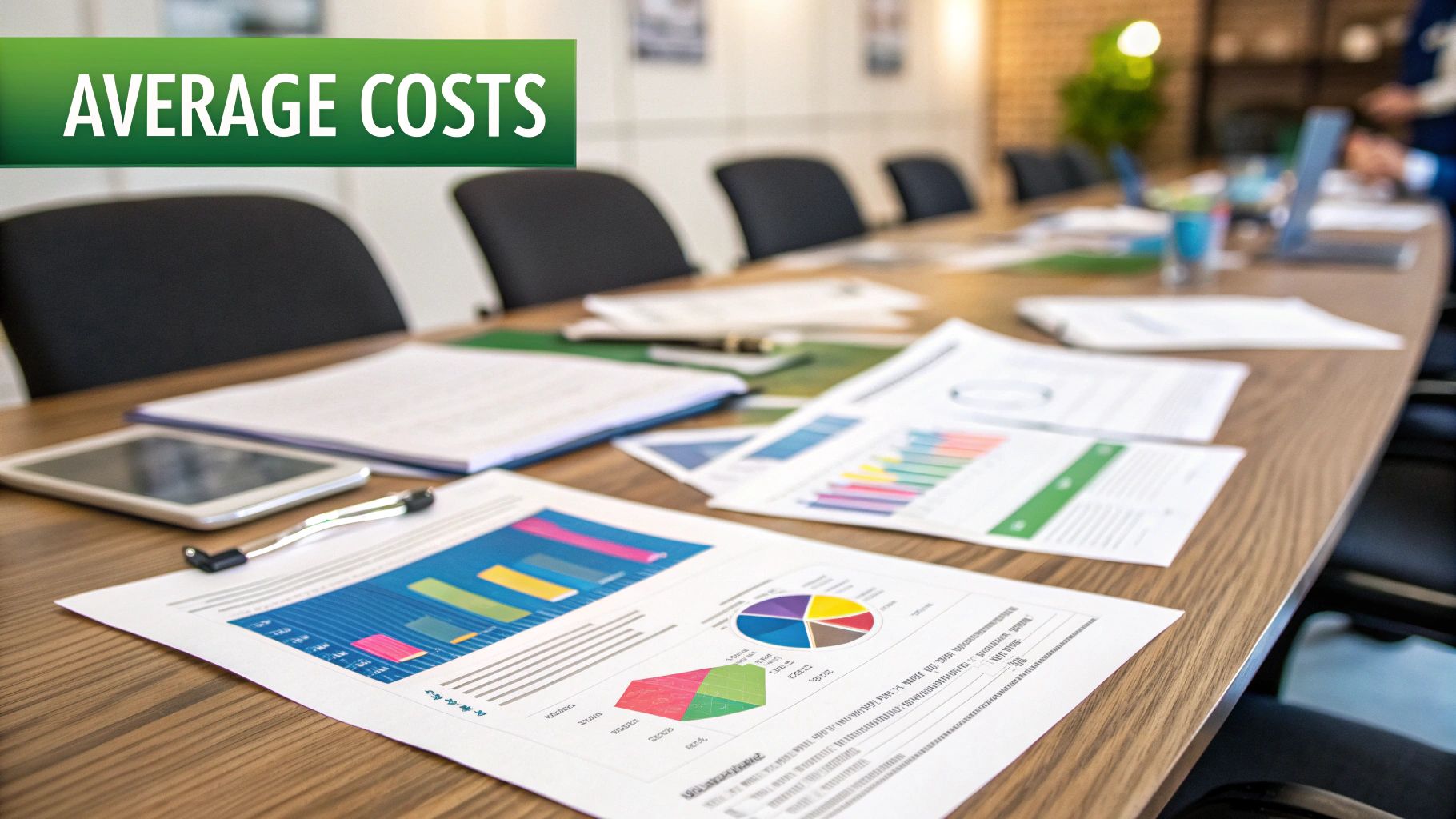When people ask about the cost of personal liability insurance, they're often surprised by how affordable it really is. For the most part, this coverage is already bundled into your standard homeowners or renters policy. If you need a separate policy, you can often find one for as little as $10 to $20 per month.
A typical policy with $100,000 in coverage might run you anywhere from $120 to $240 a year. Of course, that final price tag always comes down to your specific situation and how much protection you decide you need.
Decoding the Price of Your Financial Safety Net
Figuring out what you'll pay for personal liability insurance isn't about finding a single, magic number. It's about understanding how a handful of factors mix together to determine your unique premium. Instead of seeing it as just another bill, think of it as a flexible investment in your financial security. For what you might spend on a few streaming services, you get a powerful shield against lawsuits that could otherwise drain your savings or even threaten your home.
This protection is absolutely critical in a world where accidents are just a part of life. A guest could slip on a wet step, your dog could bite a neighbor, or a friendly game of catch in the backyard could go wrong. Any of these everyday incidents can quickly escalate into a costly legal mess. Without insurance, you're on the hook for everything—legal fees, medical bills, and settlement costs—which can easily climb into the six-figure range.
Why Costs Vary So Much
The premium you pay is a direct reflection of the risk an insurance company takes on by covering you. To figure this out, insurers look at a few key things to get a clear picture of how likely you are to file a claim.
So, what are they looking at? Let's break down the major factors.
- Coverage Limits: This one is simple. The more coverage you want (say, $500,000 versus $100,000), the more you'll pay. It's the single biggest driver of your final cost.
- Your Risk Profile: Do you have things on your property that increase the odds of an accident? Think swimming pools, trampolines, or even certain dog breeds. Insurers call these "attractive nuisances," and they can raise your premium.
- Your Location: Where you live matters. Insurance rates are heavily influenced by state and local laws, how often lawsuits are filed in your area, and the typical size of settlement awards.
- Claims History: If you've filed liability claims in the past, an insurer will see you as a higher risk. This history can, and often does, lead to higher rates.
A common misconception is that personal liability insurance is some expensive, niche product. The truth is, it's usually a core part of your homeowners, condo, or renters insurance, giving you a huge amount of protection for a small slice of your total premium.
Insurers use a mix of these elements to calculate your premium, which is why there's no such thing as a one-size-fits-all price. We've put together a table to make this even clearer.
Key Factors That Influence Your Insurance Premium
This table breaks down the main things insurers look at when pricing your personal liability policy.
| Factor | How It Affects Your Cost | Real-World Example |
|---|---|---|
| Coverage Limit | Higher limits mean higher premiums. This is the amount the insurer will pay out. | Opting for a $500,000 policy will cost more than a standard $100,000 one. |
| Property Risks | Features that increase the chance of injury on your property will raise your cost. | Owning a swimming pool or a large dog can increase your premium. |
| Location | Rates vary based on local legal trends and the frequency/cost of lawsuits. | Living in a state known for high litigation rates may lead to higher costs. |
| Claims History | A past record of liability claims signals a higher risk to the insurer. | If you filed a claim for a dog bite two years ago, your renewal rate may be higher. |
| Credit Score | In many states, a lower credit score can be seen as a sign of higher risk. | A person with a good credit history may pay less than someone with a poor one. |
Understanding these pieces helps you see the "why" behind your quote. It's a personalized calculation, not an arbitrary number.
If you want to dig deeper into what this coverage is all about, our guide on the personal liability coverage definition is a great place to start. At the end of the day, the cost is a small price to pay for such significant peace of mind.
Understanding Your Premium Levers
To get a real handle on what you pay for personal liability insurance, you need to know which levers you can actually pull. It's helpful to think of your policy less like a static, unchangeable document and more like a customizable machine. The two main controls you have are your coverage limits and your deductible. Getting these right is the secret to balancing solid protection with a premium that doesn't break the bank.
Your coverage limit is simply the maximum amount of money your insurance company will pay out if you have a covered claim. It's the total size of your financial safety net. A basic homeowners policy might come with $100,000 in liability coverage, but most financial advisors I talk to suggest aiming for at least $300,000 to $500,000 to properly protect your assets. It makes sense: a bigger safety net costs a bit more.
The other lever is your deductible. This is the portion of a claim you agree to pay yourself before the insurance company steps in. Think of it like the co-pay you have for a doctor's visit.
By opting for a higher deductible—for instance, bumping it up from $500 to $1,000—you're telling the insurer you're willing to take on a little more of the initial risk. They'll almost always reward you for that with a lower premium, and the savings can be pretty significant. It’s a classic trade-off: lower monthly payments versus a higher potential out-of-pocket cost if something happens.
Finding Your Policy's Sweet Spot
The real trick is finding that sweet spot where you feel secure without overpaying for coverage you don't realistically need. Your coverage limit and deductible choices work in tandem to shape your final premium.
This infographic gives you a quick visual breakdown of the main cost drivers.
As you can see, it really boils down to your personal risk profile, the coverage amount you choose, and the deductible you're comfortable with. Those are the pillars holding up your policy's price tag.
Another powerful lever—and one of the easiest to use—is bundling. Insurance carriers value loyalty. If you buy more than one policy from them, like your home and auto insurance, they'll usually give you a hefty discount. It’s a straightforward way to reduce your total insurance bill without cutting back on protection.
Finally, your unique personal risk factors have a huge say in your rate. Insurers look at anything on your property that might raise the chances of an accident. Common examples include:
- Swimming pools or hot tubs: These are unfortunately common sources of liability claims.
- Trampolines: In the insurance world, these are often called "attractive nuisances" for a reason—they significantly increase risk.
- Certain dog breeds: Some companies have a list of dog breeds they view as a higher liability risk.
- Vacation properties: A second home means a second set of liability risks. You can learn more about this in our guide to vacation home insurance, which covers these specific challenges.
Once you understand how these levers—coverage, deductibles, bundling, and property risks—affect your personal liability insurance cost, you're in the driver's seat. You can start making smarter choices to build a policy that gives you both peace of mind and great value.
How Global Trends Shape Your Insurance Bill
It’s always a little frustrating when you open your insurance renewal and see the price has gone up, especially if you haven't filed a single claim. It can feel random, almost unfair. But the reality is that your personal policy is connected to much bigger economic and environmental forces happening across the globe.
The best way to think about it is that the entire insurance industry is one giant, interconnected pool of money. When huge events trigger massive payouts, the whole pool shrinks. To keep the system financially sound, everyone who contributes to that pool—meaning, every policyholder—might see their premium adjusted. It’s not a penalty against you; it’s a reflection of a riskier, more expensive world.
The Impact of Natural Disasters
One of the biggest drivers of rising insurance costs today is the undeniable increase in both the number and intensity of natural disasters. We're seeing more powerful hurricanes, more widespread wildfires, and more destructive floods. Each of these events can lead to billions of dollars in claims for damaged homes and property.
When an insurer pays out those massive sums, they have to replenish their funds to stay in business. That creates a ripple effect. To ensure they can cover the next major event, they have to re-evaluate risk across the board. This is why a homeowner in a relatively calm state might see their rates creep up after a devastating hurricane season on the other side of the country.
The global insurance market is deeply interconnected. A historic wildfire season in California or a string of hurricanes hitting Florida puts a major strain on insurance resources. That pressure can lead to modest premium adjustments for everyone, even those in states with milder weather. It’s a collective system designed to absorb massive shocks.
How Inflation Raises Claim Costs
The other major piece of the puzzle is simple economic inflation. When the cost of everything goes up, the cost to settle an insurance claim goes up right along with it.
Let's say a guest gets hurt on your property. A personal liability claim might need to cover expenses like:
- Medical Care: Hospital bills, surgical procedures, and physical therapy all cost significantly more today than they did just a few years ago.
- Repairs: If the accident also caused property damage, the price of lumber, building materials, and skilled labor has shot up.
- Legal Fees: The hourly rates for lawyers and the costs associated with court proceedings also rise with inflation.
Because the potential payout for any given claim is now much higher, the premium needed to cover that risk has to increase, too. This is putting a ton of pressure on the market right now. In fact, when you combine severe weather with high inflation, you get a powerful recipe for rate hikes. For instance, after California wildfires caused $50 billion in damages in early 2025, national homeowners insurance premiums are projected to jump by 21%.
You can get a deeper look at these market pressures by reading USI's personal insurance trends report, which breaks down what to expect.
The Hidden Legal Forces Driving Up Premiums
Beyond volatile weather and rising inflation, another powerful, less visible trend is quietly pushing up your insurance premiums. It’s often called social inflation, and it’s the direct result of an increasingly aggressive and well-funded legal environment. This shift isn't just a problem for big corporations; its ripple effects are being felt in the cost of personal liability insurance for everyday people.
At its heart, social inflation describes how changing public attitudes and legal norms are driving claim costs higher, completely separate from standard economic inflation. We're simply seeing more lawsuits being filed, and the settlement amounts and jury awards are skyrocketing to historic highs. For insurers, this creates a much riskier world to operate in.
The Rise of Organized Legal Strategies
This isn't just a random spike in lawsuits. We're witnessing the growth of a sophisticated industry where hedge funds and financiers pour money into law firms that specialize in liability cases. This funding fuels aggressive litigation tactics, extensive advertising campaigns, and strategies designed to drag out legal fights. All of this inflates the cost of a claim, which in turn leads to bigger settlements or verdicts.
This trend is creating a more litigious environment across the board, pushing up liability insurance costs globally. As insurers recalculate the risk of facing these expensive lawsuits, they have to build that risk into their pricing. The fallout eventually trickles down to personal liability policies, especially for individuals who have more exposure to potential lawsuits. You can get a much deeper look at this phenomenon in the 2025 General Liability Market Outlook from DomaniRisk.
This practice, known as third-party litigation funding, essentially turns lawsuits into financial investments. Investors bet on cases they think will produce a massive payout, and in return, they take a hefty slice of the final award. This completely changes the dynamic of the legal battlefield.
Think of it like this: a simple slip-and-fall claim that might have settled for a reasonable amount a decade ago is now potentially backed by a multi-million-dollar investment fund. This gives plaintiffs’ attorneys the resources to pursue lengthy, high-pressure legal fights, rejecting smaller settlement offers in hopes of a massive verdict.
The result is a domino effect that cascades through the entire insurance industry. Insurers must now price their policies to account for the risk of these bigger, more expensive, and far less predictable legal battles. They adjust their models for the possibility of a "nuclear verdict"—an unexpectedly large jury award.
Ultimately, that increased risk is passed on to all of us through higher premiums, contributing directly to the rising personal liability insurance cost you see on your renewal notice.
Finding Value in a World of Rising Costs
It’s completely understandable to look at rising insurance premiums and see nothing but another bill to pay. With global trends and high-profile lawsuits pushing costs up, focusing on the expense is only natural. But that's not the whole story.
A better way to think about your premium is as an investment in your financial security. The real power of personal liability insurance is in a simple trade-off: you pay a small, predictable amount to avoid a devastating, completely unpredictable one. A single lawsuit could wipe out a lifetime of savings, putting your home and your family's future on the line. This insurance is the firewall standing between your assets and that kind of catastrophic loss.
An Affordable Shield in a Risky World
Even as market forces nudge prices upward, the actual personal liability insurance cost is often surprisingly reasonable, especially when you weigh it against the protection you're getting. The return on investment here isn’t about making money; it's about preventing the kind of financial ruin that can take decades to recover from.
Put it this way: you can often secure millions in liability coverage for less than what you pay for your favorite streaming services each month. Recent European data shows some comprehensive policies cost just a few euros—about the same as a single cup of coffee. You can get a better sense of how this works by reviewing the data on liability insurance affordability.
The real value isn't just about covering legal fees. It's about preserving your peace of mind and protecting your financial legacy from a single unfortunate accident. This shift in perspective transforms insurance from a grudging expense into one of the most effective financial decisions you can make.
This is especially critical if you own significant assets, like a valuable home. When you have more to lose, having a solid defensive strategy is non-negotiable. If you fall into this category, you can learn more by reading our guide to protecting your assets with high-value home insurance.
Smart Strategies to Lower Your Insurance Premium
Knowing what shapes your personal liability insurance cost is one thing, but actively managing it is where you really take charge. The good news is you have more control than you might think. There are several practical ways to bring down your premium without sacrificing the crucial protection your family and assets need.
The most direct route? Increase your deductible. Think of the deductible as your share of the cost for a claim—it's what you pay out-of-pocket before the insurance company steps in. By raising that amount, say from $500 to $1,000, you’re telling your insurer you'll cover the smaller stuff yourself. They usually see this as a lower risk for them, which often translates into a lower premium for you.
Another incredibly effective tactic is bundling your policies. Insurance companies love loyal customers. When you bring more of your business to them—like combining your home and auto insurance—they often reward you with a hefty discount. It's not uncommon to see savings of 15% or more. This is one of the simplest ways to get an immediate price break on all your coverage.
Proactive Steps for Better Rates
Beyond tweaking your policy, you can also lower your costs by simply being a lower risk. Insurers are always happy to see homeowners who take proactive steps to head off accidents before they even have a chance to happen. Making your property safer can have a direct, positive impact on what you pay.
Even small, simple measures can make a big difference:
- Secure "Attractive Nuisances": Got a swimming pool? Make sure it has a four-sided fence and a locking gate. For a trampoline, a safety net enclosure is a must. These features reduce the chance of a neighborhood kid getting hurt on your property.
- Install Safety Devices: A centrally monitored home security system or fire alarm isn't just for stopping burglars or fires. It signals to your insurer that your home is well-protected, which can earn you a nice discount on your liability coverage.
- Tackle Maintenance Issues: Fix those broken steps, tighten that wobbly handrail, and always keep your walkways clear of ice and clutter. Preventing a simple slip-and-fall is one of the best ways to avoid a liability claim in the first place.
An annual policy review is one of the most powerful—and most overlooked—tools for managing your personal liability insurance costs. Life changes, and your insurance should change with it. A quick chat with your agent might reveal new discounts you've become eligible for, like a reward for having a claims-free history.
The Power of Shopping Around
Finally, never underestimate the power of a little comparison shopping. The insurance world is competitive, and the rates for identical coverage can vary wildly from one company to the next.
Make it a habit to get quotes from at least three different insurers every couple of years. It’s the only way to be sure you aren't paying more than you have to. Many of these same cost-saving tactics apply to your other policies, too. You can learn more in our guide on how to lower home insurance premiums.
Answering Your Top Questions About Liability Insurance Costs
When you start digging into personal liability insurance, a lot of questions pop up. That's completely normal. Getting straight answers is the only way to feel good about the coverage you're buying. Let's break down some of the most common things people ask about the cost and what it actually covers.
How Much Liability Coverage Do I Really Need?
There’s no magic number here. The right amount of coverage is tied directly to your financial situation. A solid starting point is to get enough liability coverage to protect your total net worth.
Take a moment to add up your assets. Think about your home equity, cash in the bank, investment portfolios, and even valuable items you own. That total is what you stand to lose in a lawsuit.
Your lifestyle matters, too. Do you host a lot of parties? Own a swimming pool or a trampoline? Have a rental property? These things increase your risk, so you'll want a coverage limit that not only matches but comfortably exceeds your assets.
Does My Insurance Cover Dog Bites?
In most cases, yes. Your standard homeowners or renters policy usually includes personal liability protection that covers injuries caused by your pets. But—and this is a big but—you absolutely have to check the policy details.
Some insurance companies have a "dangerous breeds" list. If your dog is on that list, they might charge you a higher premium or refuse to cover dog-related incidents altogether. Always be upfront with your agent about your pets. It’s the only way to be sure you don’t have a massive, unexpected gap in your coverage.
Think of it this way: Your homeowners or auto liability is your first line of defense. An umbrella policy is the cavalry that arrives when the first line is overwhelmed. It's the powerful backup that kicks in only after a claim has exhausted your standard policy limits.
Umbrella policies give you that extra breathing room, typically starting at $1 million in coverage. This additional shield is critical if your net worth is higher than what your standard homeowners or auto policy covers. To get a better handle on this, check out our guide on how much umbrella insurance you might need to see if it makes sense for you.
Sorting through the details of your personal liability insurance cost shouldn't feel like a chore. At Wexford Insurance Solutions, we specialize in giving you clear answers and straightforward advice, ensuring you get the right protection without overpaying. Visit us online to get a quote and secure your financial future.
 Your Guide to Valuable Personal Property Insurance
Your Guide to Valuable Personal Property Insurance Understanding General Contractor Insurance Requirements You Need to Know
Understanding General Contractor Insurance Requirements You Need to Know










